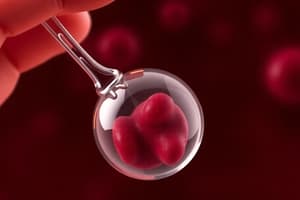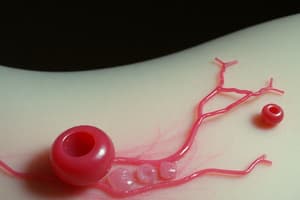Podcast
Questions and Answers
What is the role of ADP in platelet function?
What is the role of ADP in platelet function?
- Promoting vascular smooth muscle contraction
- Strengthening the fibrin clot
- Inhibiting platelet aggregation
- Inducing platelet adherence and degranulation (correct)
Which molecule is responsible for mediating platelet constriction?
Which molecule is responsible for mediating platelet constriction?
- Thromboplastin
- Serotonin (correct)
- ADP
- Thromboxane A2
What is the primary function of Thromboxane A2 in platelet aggregation?
What is the primary function of Thromboxane A2 in platelet aggregation?
- Strengthening the fibrin clot
- Inhibiting platelet degranulation
- Stimulating platelet adherence (correct)
- Promoting vasodilation
How do Prostacyclin I2 and Nitric Oxide contribute to hemostasis?
How do Prostacyclin I2 and Nitric Oxide contribute to hemostasis?
What is the main role of Thrombin in the clotting pathway?
What is the main role of Thrombin in the clotting pathway?
Which molecule strengthens the plug formed by aggregated platelets?
Which molecule strengthens the plug formed by aggregated platelets?
What is the primary role of platelets in the process of hemostasis?
What is the primary role of platelets in the process of hemostasis?
Which glycoprotein is responsible for linking platelets together to form platelet plugs?
Which glycoprotein is responsible for linking platelets together to form platelet plugs?
During which stage of hemostasis does the activation of coagulation factors lead to the production of thrombin?
During which stage of hemostasis does the activation of coagulation factors lead to the production of thrombin?
What is the function of thromboxane A2 (TxA2) in the context of platelet activity?
What is the function of thromboxane A2 (TxA2) in the context of platelet activity?
Which component is responsible for attaching activated platelets to von Willebrand Factor (vWF)?
Which component is responsible for attaching activated platelets to von Willebrand Factor (vWF)?
In the context of hemostasis, where does fibrinolysis occur?
In the context of hemostasis, where does fibrinolysis occur?
What is the primary function of nitric oxide in hemostasis?
What is the primary function of nitric oxide in hemostasis?
Which molecule is a powerful vasodilator and interferes with platelet formation and aggregation?
Which molecule is a powerful vasodilator and interferes with platelet formation and aggregation?
During primary hemostasis, what is the main function of vonWillebrand Factor (vWF)?
During primary hemostasis, what is the main function of vonWillebrand Factor (vWF)?
What initiates the vascular spasm during the hemostasis process?
What initiates the vascular spasm during the hemostasis process?
How do platelets adhere to exposed collagen during hemostasis?
How do platelets adhere to exposed collagen during hemostasis?
What is the main outcome of the secondary hemostasis process?
What is the main outcome of the secondary hemostasis process?
In the intrinsic pathway, which factor is involved in converting prothrombin to thrombin?
In the intrinsic pathway, which factor is involved in converting prothrombin to thrombin?
What is the primary activator of prothrombin in the final common pathway of coagulation?
What is the primary activator of prothrombin in the final common pathway of coagulation?
Which activated factor contributes to the activation of Factors XIa and VIIIa in the intrinsic pathway?
Which activated factor contributes to the activation of Factors XIa and VIIIa in the intrinsic pathway?
In the coagulation cascade, what is the role of Factor VIII?
In the coagulation cascade, what is the role of Factor VIII?
Which factor is crucial for converting prothrombin to thrombin in the final common pathway?
Which factor is crucial for converting prothrombin to thrombin in the final common pathway?
In the prothrombinase complex, what is the role of factor Va?
In the prothrombinase complex, what is the role of factor Va?
Which factor is involved in the activation of factor IX to factor IXa in the extrinsic pathway?
Which factor is involved in the activation of factor IX to factor IXa in the extrinsic pathway?
How does vitamin K impact the production of prothrombin and other clotting factors by the liver?
How does vitamin K impact the production of prothrombin and other clotting factors by the liver?
Which pathway is specific for coagulation initiation outside the intravascular space and is measured by PT and INR tests?
Which pathway is specific for coagulation initiation outside the intravascular space and is measured by PT and INR tests?
What is the function of Thrombin in the final common pathway of coagulation?
What is the function of Thrombin in the final common pathway of coagulation?
What is the function of prothrombinase in the clotting pathway?
What is the function of prothrombinase in the clotting pathway?
Which coagulation factor is involved in both the intrinsic and extrinsic pathways of the clotting cascade?
Which coagulation factor is involved in both the intrinsic and extrinsic pathways of the clotting cascade?
In the final common pathway of the clotting cascade, what is the primary function of fibrin?
In the final common pathway of the clotting cascade, what is the primary function of fibrin?
Which of the following accurately describes the extrinsic pathway of the clotting cascade?
Which of the following accurately describes the extrinsic pathway of the clotting cascade?
What role do coagulation factors play in the intrinsic pathway of the clotting cascade?
What role do coagulation factors play in the intrinsic pathway of the clotting cascade?
What is the significance of the final common pathway in the clotting cascade?
What is the significance of the final common pathway in the clotting cascade?
Factor XII is the first plasma protein activated in the intrinsic pathway of the clotting cascade.
Factor XII is the first plasma protein activated in the intrinsic pathway of the clotting cascade.
Thrombin plays a role in the activation of Factors XIa and VIIIa in the intrinsic pathway of the clotting cascade.
Thrombin plays a role in the activation of Factors XIa and VIIIa in the intrinsic pathway of the clotting cascade.
The final common pathway of the clotting cascade involves the conversion of prothrombin to thrombin by Xa and Va.
The final common pathway of the clotting cascade involves the conversion of prothrombin to thrombin by Xa and Va.
In the extrinsic pathway, Factor IX is activated to IXa by Factor XIa.
In the extrinsic pathway, Factor IX is activated to IXa by Factor XIa.
Prothrombinase complex consists of Xa, Va, and activated platelets in the final common pathway of coagulation.
Prothrombinase complex consists of Xa, Va, and activated platelets in the final common pathway of coagulation.
The intrinsic pathway of the clotting cascade is initiated by blood trauma and exposure to collagen.
The intrinsic pathway of the clotting cascade is initiated by blood trauma and exposure to collagen.
Thrombin generated from the extrinsic pathway is sufficient to provide adequate, sustained coagulation.
Thrombin generated from the extrinsic pathway is sufficient to provide adequate, sustained coagulation.
The final common pathway of the clotting cascade involves only the intrinsic pathway.
The final common pathway of the clotting cascade involves only the intrinsic pathway.
Prothrombinase is responsible for converting fibrinogen to fibrin in the clotting pathway.
Prothrombinase is responsible for converting fibrinogen to fibrin in the clotting pathway.
The extrinsic pathway of the clotting cascade is activated when coagulation is initiated inside the intravascular space.
The extrinsic pathway of the clotting cascade is activated when coagulation is initiated inside the intravascular space.
In the intrinsic pathway of the clotting cascade, everything necessary for clotting is found outside the blood.
In the intrinsic pathway of the clotting cascade, everything necessary for clotting is found outside the blood.
Thrombin plays a significant role in activating platelets and clotting factors in the positive feedback loop of the clotting cascade.
Thrombin plays a significant role in activating platelets and clotting factors in the positive feedback loop of the clotting cascade.
In the final common pathway of the clotting cascade, the extrinsic and intrinsic pathways merge at factor Xa to produce thrombin.
In the final common pathway of the clotting cascade, the extrinsic and intrinsic pathways merge at factor Xa to produce thrombin.
Factor III, also known as Tissue Factor (TF), is a plasma protein involved in the intrinsic pathway.
Factor III, also known as Tissue Factor (TF), is a plasma protein involved in the intrinsic pathway.
Factor VIIa forms a complex with TF (Factor III) in the extrinsic pathway to activate factor X to Xa.
Factor VIIa forms a complex with TF (Factor III) in the extrinsic pathway to activate factor X to Xa.
In the prothrombinase complex, factor Va and activated platelets help convert factor IX to IXa in the intrinsic pathway.
In the prothrombinase complex, factor Va and activated platelets help convert factor IX to IXa in the intrinsic pathway.
The extrinsic pathway is faster than the intrinsic pathway and is measured by PT and INR tests.
The extrinsic pathway is faster than the intrinsic pathway and is measured by PT and INR tests.
The liver requires vitamin K for the normal production of prothrombin and other clotting factors in both the extrinsic and intrinsic pathways.
The liver requires vitamin K for the normal production of prothrombin and other clotting factors in both the extrinsic and intrinsic pathways.
Flashcards are hidden until you start studying




